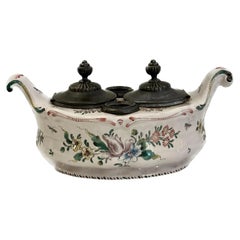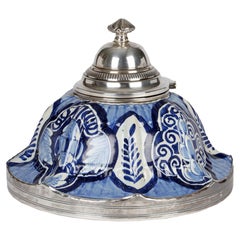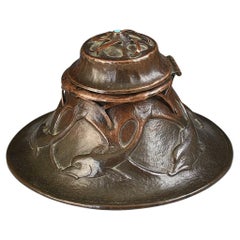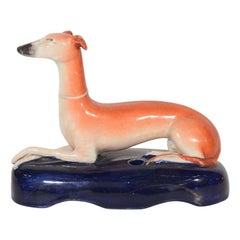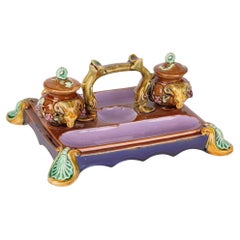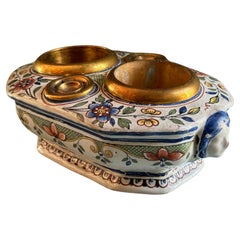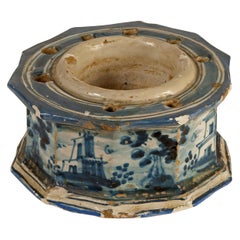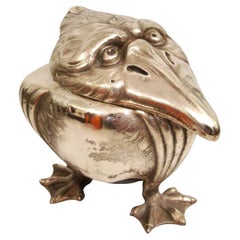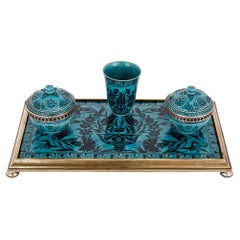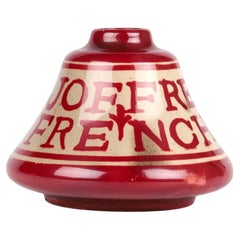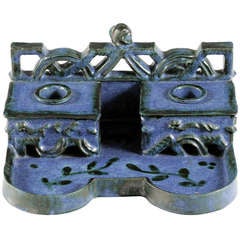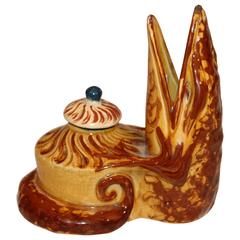Antique Pottery Inkwell
Mid-19th Century French Provincial Antique Pottery Inkwell
Faience
19th Century French Aesthetic Movement Antique Pottery Inkwell
Silver
Early 1900s British Arts and Crafts Antique Pottery Inkwell
Copper
19th Century English Antique Pottery Inkwell
Pottery
19th Century English High Victorian Antique Pottery Inkwell
Pottery
Early 19th Century European Antique Pottery Inkwell
Brass, Bronze
18th Century Spanish Rococo Antique Pottery Inkwell
Ceramic
Early 1900s German Arts and Crafts Antique Pottery Inkwell
Pewter
19th Century French Islamic Antique Pottery Inkwell
Brass
19th Century German Antique Pottery Inkwell
Pottery
Early 20th Century Italian French Provincial Antique Pottery Inkwell
Faience, Pottery
1910s English Art Deco Antique Pottery Inkwell
Ceramic
Recent Sales
Early 20th Century Austrian Jugendstil Antique Pottery Inkwell
Late 19th Century English Arts and Crafts Antique Pottery Inkwell
Pottery
Early 20th Century American Arts and Crafts Antique Pottery Inkwell
Pottery, Ceramic
Early 20th Century Antique Pottery Inkwell
Pottery
1910s British Antique Pottery Inkwell
Pottery
19th Century English Antique Pottery Inkwell
Pottery
19th Century Unknown Antique Pottery Inkwell
Siena Marble
19th Century English Antique Pottery Inkwell
Pottery
Early 19th Century English Regency Antique Pottery Inkwell
Ceramic, Pearlware, Pottery
Early 20th Century French Antique Pottery Inkwell
Faience
19th Century European Antique Pottery Inkwell
Faience
Late 19th Century English High Victorian Antique Pottery Inkwell
Pottery
19th Century French Antique Pottery Inkwell
Bronze
People Also Browsed
Late 19th Century Scottish Arts and Crafts Antique Pottery Inkwell
Brass
1910s English Arts and Crafts Antique Pottery Inkwell
Copper
20th Century Arts and Crafts Antique Pottery Inkwell
Copper
1910s American Arts and Crafts Antique Pottery Inkwell
Iron
1880s English Antique Pottery Inkwell
Porcelain
Early 1900s English Arts and Crafts Antique Pottery Inkwell
Oak
Early 20th Century American Arts and Crafts Antique Pottery Inkwell
Glass, Oak
Early 20th Century English Arts and Crafts Antique Pottery Inkwell
Enamel, Pewter
Early 20th Century American Art Nouveau Antique Pottery Inkwell
Bronze, Lead
Early 1900s Italian Art Nouveau Antique Pottery Inkwell
Bronze
1910s British Arts and Crafts Antique Pottery Inkwell
Pottery
Early 19th Century Victorian Antique Pottery Inkwell
Ceramic
Early 1900s French Art Nouveau Antique Pottery Inkwell
Copper
Early 1900s English Arts and Crafts Antique Pottery Inkwell
Copper
Mid-19th Century French Other Antique Pottery Inkwell
Porcelain
Antique Pottery Inkwell For Sale on 1stDibs
How Much is a Antique Pottery Inkwell?
Finding the Right Desk-accessories for You
Whether you’ve carved out a space for a nifty home office or you prefer the morning commute, why not dress up your desk with antique and vintage desk accessories? To best tiptoe the line between desk efficiency and desk enjoyment, we suggest adding a touch of the past to your modern-day space.
Desks are a funny thing. Their basic premise has remained the same for quite literally centuries: a flat surface, oftentimes a drawer, and potentially a shelf or two. However, the contents that lay upon the desk? Well, the evolution has been drastic to say the least.
Thank the Victorians for the initial popularity of the paperweight. The Industrial Revolution offered the novel concept of leisure-time to Europeans, giving them more time to take part in the then crucial activity of letter writing. Decorative glass paperweight designs were all the rage, and during the mid-19th-century some of the most popular makers included the French companies of Baccarat, St. Louis and Clichy.
As paper was exceedingly expensive in the early to mid-19th-century, every effort was made to utilize a full sheet of it. Paper knives, which gave way to the modern letter opener, were helpful for cutting paper down to an appropriate size.
Books — those bound volumes of paper, you may recall — used to be common occurrences on desks of yore and where there were books there needed to be bookends. As a luxury item, bookend designs have run the gamut from incorporating ultra-luxurious materials (think marble and Murano glass) to being whimsical desk accompaniments (animal figurines were highly popular choices).
Though the inkwell’s extinction was ushered in by the advent of the ballpoint pen (itself quasi-obsolete at this point), there is still significant charm to be had from placing one of these bauble-like objets in a central spot on one’s desk. You may be surprised to discover the mood-boosting powers an antique — and purposefully empty — inkwell can provide.
The clamor for desk clocks arose as the Industrial Revolution transitioned labor from outdoors to indoors, and allowed for the mass-production of clock parts in factories. Naturally, elaborate designs soon followed and clocks could be found made by artisans and luxury houses like Cartier.
Find antique and vintage desk accessories today on 1stDibs.
- 1stDibs ExpertApril 5, 2022To tell if pottery is antique, first look for any identifying marks. Usually, you will notice them on the bottom of the piece. If you locate one, you can use an authoritative resource to determine the maker. Then, you can research the pattern and shape to determine an approximate date. Pottery made over 100 years ago is generally considered an antique. Find a range of expertly vetted antique pottery on 1stDibs.
- 1stDibs ExpertAugust 8, 2024To tell if your Japanese pottery is antique, look for markings, which usually appear on the bottoms of pieces. If you see the word "Nippon," your piece was likely produced between 1891 and 1921, making it an antique. Pieces marked with the words "made in occupied Japan" originated between 1945 and 1952 and are vintage, based on their age. A "made in Japan" marking may indicate a vintage or contemporary piece. If you don't see any of these markings, consult trusted online resources to get a rough idea of when your pottery was produced. Any piece that dates back 100 years or more is antique. Should you encounter difficulty with the dating process, a certified appraiser or knowledgeable antique dealer can assist you. On 1stDibs, shop a variety of Japanese pottery.
- 1stDibs ExpertAugust 29, 2024To tell an antique Italian pottery apart from other pieces, do some research using trusted online resources. First, identify the maker by looking for marks on the bottom or interior. Once you know who produced your pottery, you can then explore the styles and types of pieces they produced over the years and use this information to estimate your piece's age. For pottery to be antique, it must be at least 100 years old. If you'd like assistance with the dating process, talk to a certified appraiser or knowledgeable antique dealer. Shop a collection of antique Italian pottery on 1stDibs.
Read More
Kazuyo Sejima’s Flowering Tree Blooms Year-Round
The brilliantly simple design turns a modest bouquet into a major statement.
He Wrote ‘Oedipus Rex,’ but Do You Know What He Looked Like?
The Greek tragedian is said to have been handsome in his day.
Cigar Culture Was Once the Peak of Masculinity. Now, It’s a Compelling Curiosity
Even for those who don’t indulge, elegant smoking accessories and audacious art portraying cigar enthusiasts hold a nostalgic allure.
African Travel Plans on Hold? This Ardmore Leopard Vase Brings the Beauty of the Savanna to You
It’s an excellent example of the sought-after ceramics coming out of South Africa’s KwaZulu-Natal province.
With a High-Tech Flagship and Cool Collabs, Lladró Is Breaking the Mold for Porcelain Production
Thanks to its new leadership, the Spanish maker of figurines, busts and lighting is on a mission to update the art of porcelain for the 21st century.
Zoë Powell’s Magnolia 05 Vessel Is Handmade from Clay She Unearthed Herself
The free-form stoneware piece is inspired by the magnolia tree and its associations with home.
8 Ways to Breathe New Life into a Space with Plants
The pair behind the Instagram account @houseplantclub share their tips for making any room of the house gloriously green.
Paris Gallerist Sandy Toupenet Gets Fired Up over 20th-Century Ceramics and Inventive New Makers
Her space on the city’s Left Bank mixes mid-century pieces by the likes of Jean Cocteau and Pablo Picasso with whimsical contemporary creations.
